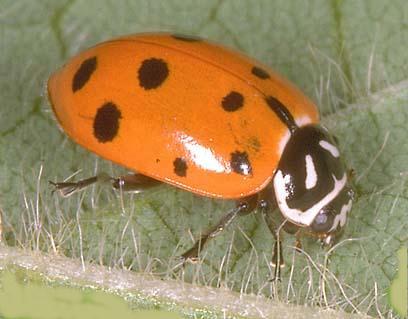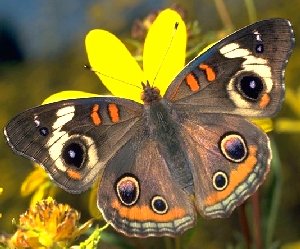What makes an insect an insect?
For one thing, it has a special body. All insects have a hard shell on the outside called an exoskeleton. The shell protects the little insect just like metal armor protects a knight.


Roach Honey Bee/Ant Silverfish Flea Butterfly
Some insects, like the flea, make themselves at home on other animals! People live together in groups called families. Some insects live together in groups, too. Ants, bees, and termites live in groups called colonies. Each member of an insect group has a special job. Some find and gather food. Some build and dig. Others take care of the young.
What do insects eat?
Some eat leaves and stems from plants and trees. others suck nectar and juice from flowers and fruit. And some insects like to eat other insects. Some insects drink blood from other animals--like you and me! other insects, like the cockroach and the fly, eat garbage, animal waste, and other dead things. But they recycle garbage to keep the earth clean!
How do insects "talk" to each other?
Ants communicate through smells. They use odors to warn their nest mates of danger and to lead them to food. Other insects send messages with movement! When a bee finds food, it will do a little dance in the nest to tell the other bees "it's time to eat!" Many insects communicate with sounds. Male field crickets chirp by rubbing their wings together to attract a female cricket. Fireflies find each other with flashes of light!
How do insects protect themselves?
Wasps use poison stings to fight off predators. Other insects wear special armor. A few insects, like the stink bug, spray stinky liquids at their enemies. They are the skunks of the insect world! Many insects have colors that blend with the places they live. This is called camouflage.
How does an insect grow up?
All insects hatch from eggs. As they grow, they get bigger and begin to look more like their parents. The change the insects go through from egg to adult is called metamorphosis. That's a big word that means "changes shape." There are different kinds of metamorphosis. Some insects change by just growing bigger. Others grow wings. But there are some insects, such as butterflies, that change so much that the adult looks like nothing like the youth.

Why Are a Dragonfly's Eyes So Big?
Dragonflies look for their food during the daytime. It is easier to find with big eyes. Those big eyes also help them watch out for enemies that would catch them. Because they have such big eyes, it is easier to get away. A dragonfly's eye is made up of many small eyes. Each tiny eye sees almost the same thing. Most insects have the same kind of eye a dragonfly has.
 Ladybug
Ladybug
Why do ladybugs spit yellow liquid when they are caught?
That yellow liquid is the ladybug's way of protecting itself from its enemies. Put a little bit of it on your fingertip and sniff. It smells terrible, and tastes even worse. If an insect or bird tries to eat a ladybug once it will not try it the next time. So you can see that this liquid helps keep ladybugs alive.
 Common Buckeye Butterfly
Common Buckeye Butterfly
HOW DOES A CATERPILLAR BECOME A BUTTERFLY?
Have you ever heard people say that a butterfly never eats? This happens to be true of some butterflies--and the reason lies in the story of how a caterpillar changes into a butterfly.
During her life, a female butterfly lays from 100 to several thousand eggs. She is very careful to lay these eggs near the kind of plant will be useful to her offspring later. if there is only one such plant in a certain area--that's where she'll lay the eggs!
From these eggs hatch out tiny, wormlike grubs, called "caterpillar larvae." They begin at once to feed and grow, and as they grow the shed their skins several times. All the caterpillars do during this time is eat and eat--because the food they store away now may have to last them for the rest of their lives when they become butterflies! The food is stored as fat, and is used to build up wings, legs, sucking tubes, and so on, when the caterpillar becomes a butterfly.
At a certain time the caterpillar feels it's time for change, so it spins a little button of silk, to which it clings. It hangs head down, sheds its caterpillar skin, and then appears as a pupa or chrysalis. The chrysalis clings to the button of silk by a sharp spine at the end of its body.
The pupa or chrysalis may sleep for some weeks or months. During this time, however, it is undergoing a change, so that when it comes out it us full-grown insect. When it emerges from its chrysalides skin, it is a butterfly--but it doesn't do any flying at first. It sits still for hours to let its wings spread out and become dry and firm. It waves them back and forth slowly until it feels they are ready to use for flying--then off it goes on its first flight in search of nectar!
By the way, the life history of the moth is
almost exactly the same as the of a butterfly.
And did you know that there are many more different kinds of moths than there
are butterflies? In

The Egg is a tiny round, oval, or
cylindrical object, usually with fine ribs and other microscopic structures.
The female attaches the egg to leaves, stems, or other objects, usually on or
near the intended caterpillar food.
 The caterpillar (or larva) is the long
worm-like stage of the butterfly or moth. It often has an interesting pattern
of stripes or patches, and may have spine-like hairs. It is the feeding and
growth stage. As it grows, it sheds its skin four or more times so as to
enclose its rapidly growing body.
The caterpillar (or larva) is the long
worm-like stage of the butterfly or moth. It often has an interesting pattern
of stripes or patches, and may have spine-like hairs. It is the feeding and
growth stage. As it grows, it sheds its skin four or more times so as to
enclose its rapidly growing body.
 The chrysalis (or pupa) is the
transformation stage within which the caterpillar tissues are broken down and
the adult insect's structures are formed. The chrysalis of most species
is brown or green and blends into the background. Many
species over winter in this stage.
The chrysalis (or pupa) is the
transformation stage within which the caterpillar tissues are broken down and
the adult insect's structures are formed. The chrysalis of most species
is brown or green and blends into the background. Many
species over winter in this stage.
 The adult (or imago) is the colorful
butterfly or moth we usually see. It is the
The adult (or imago) is the colorful
butterfly or moth we usually see. It is the
reproductive and mobile stage for the species. The adults undergo
courtship, mating, and egg-laying. The adult butterfly or moth is also
the stage
that migrates or colonizes new habitats.
 Firefly
Firefly
WHAT IS THE PURPOSE OF A FIREFLY LIGHT?
The light of the firefly is very much like other kinds of light--except that it is produced without heat. This kind of light is called "luminescence." In the firefly, luminescence is produced by a substance called "Lucifer." This combines with oxygen to produce light.
But this reaction won't take place unless another substance, called "luciferase." is present. Luciferase acts a catalyst; that is, it helps the fireflies have luciferin and Luciferase in their bodies. The Luciferase enables the luciferin to burn up and produce light.
Now, scientists can produce this same kind of light in the laboratory. But in order to do so, they must obtain the ingredients from the firefly! Chemists cannot produce them synthetically. It remains a secret of nature!
What is the purpose of this light in the firefly? Well, there are some explanations, for it, of course. One is that perhaps this helps the fireflies find their mates. Another purpose might be to serve as a warning to night-feeding birds so that they will avoid the fireflies.
But scientist still feel that they don't really know why these lights are necessary to the firefly, since the above reasons don't seem important enough. They think the light may just be a byproduct of some other chemical process that goes on in the firefly's body. A light happens to be produced, but it's not a vital process. Well, whatever the reason for the light, I'm sure most of us are glad it's there--because of the pleasure of seeing these little insects as they move about at night.
Bet you didn't know........
Flies can taste with their feet!
When in flight, a mosquito beats its wings 300 times in a single second!
The waterstrider can actually walk on water!
A flea can jump over 200 times its own length!
One ladybug can lay up to 1500 eggs in their lifetime!
Cockroaches are so smart that they have learned to run mazes in laboratories!
The giant water bug has been known to eat tadpoles and small fish!
A dragonfly can fly as fast as 30 miles per hour!
Some bee hives have up to 50,000 bees!
A cricket can hear with its legs!

